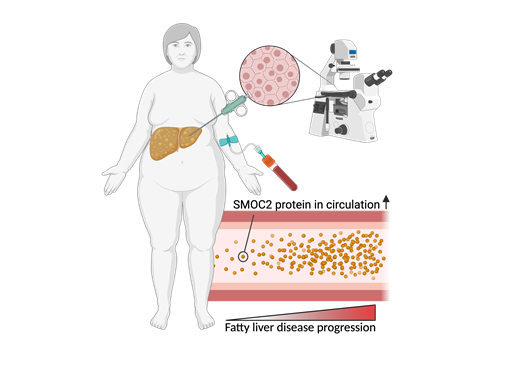Non-alcoholic fatty liver disease (NAFLD) and its progressive form, NASH, are the most common forms of chronic liver diseases affecting nearly 25% of the adult population globally. NASH may lead to liver cirrhosis and eventually liver cancer if left untreated. Costly and invasive liver needle-biopsies are the gold standard for diagnosing NASH, and currently there are no approved, blood-borne biomarkers to substitute for these biopsies in the clinic. Liver biopsies require that patients are referred to the hospital, which complicates timely detection of NASH critical for effective management of the disease. Further, needle biopsies are not always representative for the entire liver and may hence miss the full picture regarding liver health.
Researchers in ATLAS and collaborators have now discovered the circulating protein SMOC2 found in patient blood as a promising biomarker of NASH. Together with TREM2, another non-invasive NASH biomarker recently discovered by ATLAS researchers, SMOC2 may profoundly change the procedure of NASH diagnosis, beginning already in the primary care setting, and reduce the number of required liver biopsies.
“SMOC2 is an important discovery as this protein reflects formation of scar tissue, while TREM2 reflects liver inflammation. These are the two hallmark biological processes of NASH development. From a blood sample, these two proteins may therefore provide insight into the health of the whole liver thereby reducing the need for liver biopsies and making it easier for clinicians to detect NASH early on”, says Frederik T. Larsen, first-author on the study.

SMOC2 is a promising blood-borne biomarker of NASH, which may reduce or replace costly and invasive liver needle biopsies currently used for NASH diagnosis.
The discovery of SMOC2 as a NASH biomarker involved researchers from all disciplinary branches of ATLAS. It is an excellent example of how patient samples taken in the clinic and entrusted to science, are investigated in the collaborating research laboratories to provide biological insight, which may now return to the clinic as an improved diagnostic regimen to the benefit of the patient.
ATLAS researchers have already taken the first steps in establishing a wider setup for SMOC2 detection in patient blood and will use this to conduct larger validation studies of circulating SMOC2 for early diagnosis of NASH and other serious liver diseases.
The study was conducted by ATLAS - Center for Functional Genomics and Tissue Plasticity as a collaboration between several research groups from University of Southern Denmark, Odense University Hospital, and Hospital of South West Jutland. ATLAS is a center of Excellence funded by the Danish National Research Foundation.
The study is now published in Journal of Hepatology Reports
Correspondence may be directed to Associate Professor and ATLAS Partner Kim Ravnskjaer